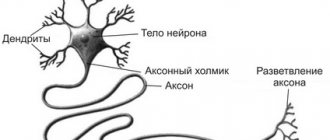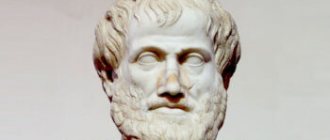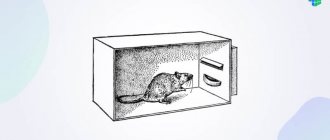9 - 2011 Sofya Skrylina, teacher of information technology, St. Petersburg
Visual perception is a set of processes for constructing a visual image of the surrounding world, the ability to comprehend what you see. These processes provide the perception of color, space, direction and shape of objects. When examining an object, a person always tries to understand what he sees. But what he saw does not always correspond to reality. There are objective patterns of visual perception that a designer must know and use in his work. After all, the success of his final product primarily depends on how the consumer perceives it.
Features of visual perception
Consistency and selectivity
When looking at any objects, the eyes move, simultaneously and in concert. The eyes are designed in such a way that they can recognize only one image at a time, then move on to the next, etc. It turns out that a person looks sequentially. The gaze moves from one part of the image to another, repeating the same path several times. The fragments of the image that a person looks at most often are the centers of meaning. In Fig. Figure 1 shows an example of the trajectory of eye movement when viewing the profile of Nefertiti.
As can be seen from the trajectory, the main elements on the face that attract attention are the eyes, nose and lips. And from a variety of objects, in most cases the choice will fall on the image of a person or an animal.
Rice. 1. An example of the trajectory of eye movement when viewing the profile of Nefertiti
The points at which, when viewing an image, the eyes stop and change direction are called the points of maximum curvature of a given section of the contour. Such points are most important for identifying a figure. Sharp breaks in lines are used in cross stitch and carpet designs, and are often used by artists to achieve greater expressiveness and stylization of images (Fig. 2).
Rice. 2. “Peasant Woman” by Ivan Goryushkin-Sorokopudov as an example of a drawing with sharp breaks in lines
Reaction to movement
The visual apparatus is designed in such a way that when a moving object appears in the field of view, the gaze is almost instantly transferred to it, and then tracks the movement. This property of the eyes is widely used by professional designers to attract attention to commercials, animated presentations, scrolling text, etc.
Integrity of perception
A person is able to imagine and see the image as a whole, looking at its individual parts. Several random curved lines, perceived as a whole, can create a new and unexpected image. A person subconsciously tries to combine the elements of an image. Examples of such simple pictures are shown in Fig. 3.
Rice. 3. Examples of holistic perception of lines
Memorability
Of the many elements of the image or object under consideration, a person can simultaneously perceive and remember no more than 7-9 in a short time. Look at the picture for a few seconds (Fig. 4), close your eyes and try to remember the fragments you saw. Most likely, there will be no more than nine of them. When creating complex compositional works, posters and exhibitions, do not forget this property of perception, do not overload your work.
Rice. 4. Rembrandt. Musical part
Constancy
Constancy of visual perception is the relative constancy of the size, shape, color of objects that are perceived when the distance, angle, and illumination change. Thus, constancy is the ability to recognize objects from different points of view, in different projections. The constancy of perception is ensured by experience, which is acquired in the process of individual development of the individual. If perception were not constant, then with every step, turn, movement, change in illumination, we would not be able to recognize what was previously known. Thanks to constancy, we can assign a seen object to the desired class, for example, combine all conceivable images of cats into one concept “cat” (Fig. 5).
Rice. 5. An example of constancy of perception
Correlativity
Correlativity is the ability of perception, expressed in the fact that all the properties of some objects are perceived in comparison with the same properties of other objects. If there is only one item in the picture, you probably won't be able to tell whether it's big or small. You should place it in some kind of environment, surround it with other objects, and compare its size with the known sizes of other objects (Fig. 6).
Rice. 6. An example of the perception of an object depending on its environment
Correlativity allows you to enhance the impression of multicolored images when using a limited number of colors: dark on a light background seems darker, and vice versa (Fig. 7).
A person’s subconscious desire to compare objects sometimes leads to visual errors and illusions.
Rice. 7. Dependence of color perception on contrast: the upper (lower) part of the inner rectangle located on the right appears significantly lighter (darker) than the same part of the rectangle located on the left
Light sensitivity of the human eye
The ability of the eye to perceive light and recognize varying degrees of its brightness is called light perception, and the ability to adapt to different brightness of lighting is called adaptation of the eye; light sensitivity is assessed by the threshold value of the light stimulus. A person with good eyesight can see the light from a candle at a distance of several kilometers at night. Maximum light sensitivity is achieved after a sufficiently long dark adaptation. It is determined under the influence of light flux in a solid angle of 50° at a wavelength of 500 nm (maximum sensitivity of the eye). Under these conditions, the threshold light energy is about 10−9 erg/s, which is equivalent to the flux of several optical quanta per second through the pupil. The contribution of the pupil to the regulation of eye sensitivity is extremely insignificant. The entire range of brightness that our visual mechanism is capable of perceiving is enormous: from 10−6 cd•m² for an eye completely adapted to darkness, to 106 cd•m² for an eye completely adapted to light. The mechanism for such a wide range of sensitivity lies in decomposition and restoration photosensitive pigments in the retinal photoreceptors - cones and rods. The human eye contains two types of light-sensitive cells (receptors): highly sensitive rods, responsible for twilight (night) vision, and less sensitive cones, responsible for color vision.
Normalized graphs of the light sensitivity of the cones of the human eye S, M, L. The dotted line shows the twilight, “black and white” susceptibility of the rods.
In the human retina there are three types of cones, the maximum sensitivity of which occurs in the red, green and blue parts of the spectrum. The distribution of cone types in the retina is uneven: "blue" cones are found closer to the periphery, while "red" and "green" cones are randomly distributed. The correspondence of cone types to three “primary” colors allows the recognition of thousands of colors and shades. The spectral sensitivity curves of the three types of cones partially overlap, which contributes to the phenomenon of metamerism. Very strong light excites all 3 types of receptors, and is therefore perceived as blinding white radiation.
Uniform stimulation of all three elements, corresponding to the weighted average of daylight, also produces the sensation of white.
Human color vision is controlled by genes encoding light-sensitive opsin proteins. According to proponents of the three-component theory, the presence of three different proteins that respond to different wavelengths is sufficient for color perception.
Most mammals have only two of these genes, which is why they have black and white vision.
The red light-sensitive opsin is encoded in humans by the OPN1LW gene. Other human opsins are encoded by the genes OPN1MW, OPN1MW2 and OPN1SW, the first two of which encode proteins that are sensitive to light at medium wavelengths, and the third is responsible for an opsin that is sensitive to the short-wavelength part of the spectrum.
Illusory
Illusory - errors in visual perception, optical illusion. There are several causes of visual illusions:
- Sometimes illusions appear as a result of specially created, special observation conditions, for example, observation with one eye, with fixed axes of the eyes, through a slit, etc. Such illusions disappear when unusual viewing conditions are removed.
- The overwhelming majority of visual illusions arise not because of the optical perfection of the eye, but because of a false judgment about what is visible, so we can assume that deception here arises when comprehending the visual image. Such illusions disappear when observing conditions change, when simple comparative measurements are performed, and when certain factors that interfere with correct perception are eliminated.
- There are a number of illusions known that are caused by the optical imperfection of the eye and some special properties of various analyzers involved in the visual process (retina, nerve reflexes).
Let's look at graphic illusions in images as examples.
Introduction
Our overall visual perception depends on many factors. Measuring visual acuity using the Snellen high-letter contrast chart provides information on just one measure of overall visual perception. Although visual acuity is the most frequently measured quantitative parameter in clinical practice, it actually poorly correlates with the dynamic range of tasks performed by the human visual system in real-world conditions [1]. To more fully describe people's overall level of satisfaction with visual perception, it is necessary to take into account factors such as spatial orientation, discrimination efficiency, and duration of visual perception without fatigue [2]. In addition, and this is especially true for CL users, it should be taken into account that the general feeling of visual comfort includes a combination of visual and physical sensations [3]. This article examines the key parameters for assessing the effectiveness of visual perception and their role in overall satisfaction with vision in real-world situations, as well as the possible influence on this perception of the design and material of corrective lenses.
Illusions associated with the structural features of the eye
Blind spot
The presence of a blind spot on the retina was first discovered in 1668 by the famous French physicist E. Mariotte. The fact is that the retina of the eye in the place where the optic nerve enters the eye does not have light-sensitive nerve fiber endings. Therefore, images of objects falling on this place of the retina are not transmitted to the brain, and therefore are not perceived. A blind spot, it would seem, should prevent us from seeing the entire object, but under normal conditions we do not notice this. In Fig. 8 the disappearing figure is replaced by a white background. Close your left eye and look with your right eye at the cross shown on the left, holding the drawing at a distance of 1520 cm from the eye. At a certain position of the drawing relative to the eye, the image of the oval ceases to be visible.
Rice. 8. The illusion of a disappearing figure
Irradiation
Many illusions are based on the irradiation effect (from the Latin irradio - to shine, to emit rays), which occurs when observing light figures and objects on a black background and vice versa. Look closely at the black square on a white background and the white square on a black background (Fig. 9). The white square appears larger than the black one. This is an optical illusion. In fact, the squares are exactly the same.
Examples of illusions of non-parallelism of parallel lines are also based on the irradiation effect (Fig. 10).
Rice. 9. A white square on a black background appears larger than a black square on a white background.
Rice. 10. A specially selected combination of various design elements creates the illusion of distorted parallel lines
Illusion of movement
Take a close look at the images in Fig. 11. You will see that the fish are swimming, the star is pulsating, and the circles are rotating.
Rice. 11. The illusion of moving objects
What does a person see
Thanks to vision, we receive 90% of information about the world around us, so the eye is one of the most important sense organs. The eye can be called a complex optical device. Its main task is to “transmit” the correct image to the optic nerve.
Structure of the human eye
The cornea is the transparent membrane that covers the front of the eye. It lacks blood vessels and has great refractive power. Part of the optical system of the eye. The cornea borders the opaque outer layer of the eye, the sclera.
The anterior chamber of the eye is the space between the cornea and the iris. It is filled with intraocular fluid.
The iris is shaped like a circle with a hole inside (the pupil). The iris consists of muscles that, when contracted and relaxed, change the size of the pupil. It enters the choroid of the eye. The iris is responsible for the color of the eyes (if it is blue, it means there are few pigment cells, if it is brown, it means a lot). Performs the same function as the aperture in a camera, regulating the light flow.
The pupil is an opening in the iris. Its size usually depends on the light level. The more light, the smaller the pupil.
The lens is the “natural lens” of the eye. It is transparent, elastic - it can change its shape, almost instantly “focusing”, due to which a person sees well both near and far. Located in the capsule, held in place by the ciliary band. The lens, like the cornea, is part of the optical system of the eye. The transparency of the human eye lens is excellent, transmitting most light with wavelengths between 450 and 1400 nm. Light with a wavelength above 720 nm is not perceived. The lens of the human eye is almost colorless at birth, but becomes yellowish with age. This protects the retina from exposure to ultraviolet rays.
The vitreous is a gel-like transparent substance located in the back of the eye. The vitreous body maintains the shape of the eyeball and is involved in intraocular metabolism. Part of the optical system of the eye.
Retina - consists of photoreceptors (they are sensitive to light) and nerve cells. Receptor cells located in the retina are divided into two types: cones and rods. In these cells, which produce the enzyme rhodopsin, the energy of light (photons) is converted into electrical energy of the nervous tissue, i.e. photochemical reaction.
The sclera is the opaque outer layer of the eyeball that merges at the front of the eyeball into the transparent cornea. 6 extraocular muscles are attached to the sclera. It contains a small number of nerve endings and blood vessels.
The choroid - lines the posterior part of the sclera, adjacent to it is the retina, with which it is closely connected. The choroid is responsible for the blood supply to intraocular structures. In diseases of the retina, it is very often involved in the pathological process. There are no nerve endings in the choroid, so when it is diseased, there is no pain, which usually signals some kind of problem.
Optic Nerve - The optic nerve carries signals from nerve endings to the brain.[6]
A person is not born with an already developed organ of vision: in the first months of life, the formation of the brain and vision occurs, and by about 9 months they are able to almost instantly process incoming visual information. In order to see, light is needed. [3]
Illusion of whole and part
Many erroneous visual impressions are due to the fact that we perceive figures and their parts not separately, but always in some relationship with other figures surrounding them, some background or setting. This section includes, perhaps, the largest number of visual illusions encountered in practice.
Müller-Lier arrow illusions
In Fig. Figure 12 shows three illusions of arrows by the famous German sociologist Müller-Lier. The illusion on the left is that the topmost horizontal arrow appears shorter than the bottom ones, but in fact all three are equal. In the picture in the middle, the imaginary lines connecting the ends of the arrows appear slanted, although in fact they are vertical. In the picture on the right, the red dot is exactly in the center of the horizontal line, although the left line appears to be smaller.
Rice. 12. Examples of Müller-Lier arrows
Ebbinghaus illusion
The Ebbinghaus illusion, or Titchener circles, is an optical illusion in the perception of relative sizes. In Fig. 13 shows two series of circles. The black circle on the right appears to be larger than the one on the left, although in fact they are the same size.
Rice. 13. Classic illusion of object size distortion: the inner circles are the same in both cases
Physiological mechanism of perception
The physiological basis of perception is the processes taking place in the sense organs, nerve fibers and the central nervous system. Under the influence of stimuli at the endings of the nerves present in the sensory organs, nervous excitation arises, which is transmitted along pathways to the nerve centers, and, ultimately, to the cerebral cortex. Here it enters the sensory zones of the cortex, which represent, as it were, the central projection of the nerve endings present in the sense organs. Depending on which organ the sensory zone is connected to, certain sensory information is generated.
Since perception is closely related to sensation, it can be assumed that it, like sensation, is a reflexive process. Ivan Petrovich Pavlov showed that perception is based on conditioned reflexes, i.e. temporary nerve connections formed in the cerebral cortex when receptors are exposed to objects or phenomena.
Temporary nerve connections that ensure the process of perception can be of two types: 1. Formed within the same analyzer; 2. Interanalyzer.
The first type occurs when the body is exposed to a complex stimulus of one modality (for example, a melody). The second type of neural connections formed under the influence of a complex stimulus are connections within different analyzers, the emergence of which Sechenov explained by the existence of associations. These associations in humans are necessarily accompanied by an auditory image of the word, thanks to which the perception acquires a holistic character.
Revaluation of vertical lines
A person determines horizontal distances more accurately by eye than the height of objects. Therefore, most people exaggerate the vertical extent compared to the horizontal, and this also leads to visual illusions. If you ask a number of people to draw vertical and horizontal lines of the same length, then in most cases the drawn vertical lines will be shorter than the horizontal ones. When the eye divides a vertical line in half, the middle is usually too high (Fig. 14a).
Rice. 14. The illusion of vertical and horizontal lines: a - it seems that the height of the triangle is not divided into equal parts; b - a figure made of horizontal lines seems narrower and taller
In Fig. 14b it seems to us that the right figure is narrower and higher (the gaze slides vertically) than the left figure. In fact, both of these figures are shaded squares with equal sides.
Differences in vision between humans and animals. Metamerism in photography
Human vision is a three-stimulus analyzer, that is, the spectral characteristics of color are expressed in only three values. If compared radiation fluxes with different spectral compositions produce the same effect on the cones, the colors are perceived as the same.
In the animal world, there are four- and even five-stimulus color analyzers, so colors perceived as the same by humans may seem different to animals. In particular, birds of prey see traces of rodents on the paths to their burrows solely due to the ultraviolet luminescence of the components of their urine. A similar situation arises with image recording systems, both digital and analog. Although most of them are three-stimulus (three layers of film emulsion, three types of cells in the matrix of a digital camera or scanner), their metamerism is different from the metamerism of human vision. Therefore, colors perceived by the eye as the same may appear different in a photograph, and vice versa. [7]
Exaggeration of sharp corners
Many illusions are explained by the ability of our vision to exaggerate the sharp angles we see on flat figures. Perhaps this kind of illusion arises due to the phenomenon of irradiation, since the light space we see expands near the dark lines delimiting the acute angle. The direction of eye movement and their mobility in general are of great importance for these illusions. If there is a break in the lines, then our gaze first falls on the acute angle.
Sharp corners always seem larger than they actually are, which is why certain distortions appear in the relationship between the parts of the visible figure. In Fig. 15 parallel straight lines, due to the influence of the background, appear non-parallel and curved.
Rice. 15. Illusions of non-parallelism of parallel lines
Illusion of distortion of right angle and circle
Sometimes a change in the direction of lines and distortion of the shape of a figure occurs due to the fact that the eye follows the directions of other lines in the field of vision. In Fig. 16a, the sides of the square look slightly convex against the background of concentric circles, but in Fig. 16b, the circle appears somewhat distorted against the background of diverging rays.
Rice. 16. Illusions of distortion of right angles and circles
Changes in vision with age
Elements of the retina begin to form at 6–10 weeks of intrauterine development, final morphological maturation occurs by 10–12 years. As the body develops, a child’s color perceptions change significantly. In a newborn, only rods function in the retina, providing black and white vision. The number of cones is small and they are not yet mature. Color recognition at an early age depends on the brightness, and not on the spectral characteristics of the color. As the cones mature, children first distinguish yellow, then green, and then red colors (from the age of 3 months they were able to develop conditioned reflexes to these colors). Cones begin to function fully by the end of 3 years of life. At school age, the discriminating color sensitivity of the eye increases. The sense of color reaches its maximum development by the age of 30 and then gradually decreases.
In a newborn, the diameter of the eyeball is 16 mm, and its weight is 3.0 g. The growth of the eyeball continues after birth. It grows most intensively in the first 5 years of life, less intensively - up to 9-12 years. In newborns, the shape of the eyeball is more spherical than in adults; as a result, in 90% of cases they have farsighted refraction.
The pupil of newborns is narrow. Due to the predominance of the tone of the sympathetic nerves innervating the muscles of the iris, at 6–8 years the pupils become wide, which increases the risk of sunburn of the retina. At 8–10 years of age, the pupil narrows. At 12–13 years of age, the speed and intensity of the pupillary reaction to light becomes the same as in an adult.
In newborns and preschool children, the lens is more convex and more elastic than in an adult, its refractive power is higher. This allows a child to clearly see an object at a shorter distance from the eye than an adult. And if in a baby it is transparent and colorless, then in an adult the lens has a slight yellowish tint, the intensity of which may increase with age. This does not affect visual acuity, but may affect the perception of blue and violet colors.
Sensory and motor functions of vision develop simultaneously. In the first days after birth, eye movements are asynchronous; when one eye is motionless, the movement of the other can be observed. The ability to fixate an object with one’s gaze is formed between the ages of 5 days and 3–5 months.
A reaction to the shape of an object is already observed in a 5-month-old child. In preschoolers, the first reaction is caused by the shape of an object, then by its size, and lastly by color. Visual acuity increases with age, and stereoscopic vision also improves. Stereoscopic vision reaches its optimal level by the age of 17–22, and from the age of 6, girls have higher stereoscopic visual acuity than boys. The field of view increases rapidly. By age 7, its size is approximately 80% of an adult's visual field.[11,12]
After 40 years, there is a decline in the level of peripheral vision, that is, the field of vision narrows and the lateral view deteriorates. After about 50 years of age, the production of tear fluid decreases, so the eyes are less hydrated than at a younger age. Excessive dryness can be expressed in redness of the eyes, pain, watery eyes when exposed to wind or bright light. This may not depend on normal factors (frequent eye strain or air pollution).
With age, the human eye begins to perceive the surroundings more dimly, with a decrease in contrast and brightness. The ability to recognize colors, especially those that are close in color, may also be impaired. This is directly related to the reduction in the number of retinal cells that perceive shades of color, contrast, and brightness. [14,15]
Some age-related visual impairments are caused by presbyopia, which manifests itself as unclear, blurred images when trying to look at objects located close to the eyes. The ability to focus vision on small objects requires accommodation of about 20 diopters (focusing on an object 50 mm from the observer) in children, up to 10 diopters at age 25 (100 mm) and levels of 0.5 to 1 diopter at age 60 (ability focusing on an object 1-2 meters away). It is believed that this is due to a weakening of the muscles that regulate the pupil, while the reaction of the pupils to the light flux entering the eye also worsens. [13] Therefore, difficulties arise with reading in dim light and the adaptation time increases when there are changes in illumination.
Also, with age, visual fatigue and even headaches begin to occur more quickly.
Associativity
Associativity establishes connections between individual representations, as a result of which one of them causes a second, a third, etc. Let us take as a simple example the emotional visual perception of a line. When looking at different lines, different feelings and emotions arise. Different shapes of lines, their direction are elements of expressiveness:
- thick, bold lines make the shape heavier, creating the impression of weight, mass;
- vertical lines evoke a feeling of stability, convey upward striving, growth, solemnity;
- horizontal - symbolize solidity, peace, silence;
- spiral - characterize rotational movement, development;
- broken lines - associated with aggressiveness, imbalance;
- wavy - express movement of varying speeds;
diagonal and oblique - symbolize dynamics:
- ascending lines are associated with hope, takeoff, rise,
- descending - cause a feeling of instability, sadness, melancholy, powerlessness.
Necker cube
Proponents of the theory of top-down processing of sensory information cite an optical illusion called the “Necker Cube” as an argument for their correctness. With its help, they clearly demonstrate that an incorrect hypothesis leads to errors of perception and an incorrect understanding of reality. If you look long and closely at this cube, you can see how the arrangement of its faces changes. In other words, this physical model is unstable and actually creates two different perceptions.
According to top-down processing theorists, this is because the human brain develops two equally valid and viable hypotheses based on incoming sensory data and previous experience, and then cannot decide which one to choose.
Imagery
Imagery is the ability to excite artistic images in the mind, based on associativity. For example, the sight of a sea shell evokes the ocean, the depths of the sea. Sometimes an object that has never been seen before contributes to the emergence of some close, long-familiar image.
In psychodiagnostics, to assess the emotional attitude to the world around us, the Rorschach test is used, which consists of ten standard tables with black-and-white and color symmetrical amorphous images (“Rorschach spots”). The subject is asked to answer the question about what is depicted or what what is depicted looks like (Fig. 17). Attitude to color is an indicator of emotional state, and the degree of originality of answers characterizes intelligence.
Rice. 17. Examples of Rorschach blots
The next stage in the evolution of contact lenses
In April 2022, the US Food, Drug and Cosmetic Administration (FDA) approved the use of CLs with the additional feature of automatically darkening the lens when exposed to bright light. Acuvue Oasys lenses with Transitions* technology were developed over 10 years in a strategic partnership with Transitions Optical. These are the first contact lenses in their category that provide users with vision correction and have a dynamic photochromic filter that constantly balances the amount of light affecting the eyes. Once these lenses go on sale in 2022, we expect to receive more information, clinical trial results and patient feedback on this new adaptive filter technology within a few months.
Empirical characteristics of visual perception
At its core, the process of perception has a dual nature: perception is maximally objective at the level of primary sensory processes; at the same time, perception is deeply subjective in the subsequent interpretation of the received information, when imagination and memory are included in the processing.
Are you an expert in this subject area? We invite you to become the author of the Directory Working Conditions
In addition, perception has a number of unique characteristics, including the properties of constancy, objectivity, integrity and generality.
Research by scientists (A.R. Luria, M.S. Pevzner, V.I. Lubovsky, S.Ya. Rubinshtein, etc.) gives grounds to classify only those conditions as mental retardation in which there is a persistent, irreversible impairment of predominantly cognitive activity caused by organic damage to the cerebral cortex. It is these signs (persistence, irreversibility of the defect and its organic origin) that should be primarily taken into account when diagnosing mental retardation.
As S.Ya. points out. Rubinstein (1986), mental retardation is not just a “small amount of intelligence”, it is qualitative changes in the entire psyche, the entire personality as a whole, resulting from organic damage to the central nervous system. This is a developmental atypia in which not only the intellect suffers, but also all higher mental functions (perception, memory, attention, imagination, speech), as well as emotions, will, behavior, and physical development. This diffuse nature of the pathological development of mentally retarded children follows from the characteristics of their higher nervous activity.
The main features of the mental development of children with mental retardation include: lack of formation of higher forms of cognitive activity (analysis, synthesis, generalization, abstraction); concreteness and superficiality of thinking; delayed speech development; immaturity of the emotional-volitional sphere.
In general, the psyche of a mentally retarded child is a unique system, the defectiveness of which causes various deviations in ongoing mental processes and activity in general. First of all, mentally retarded people are characterized by underdevelopment of cognitive interests, which is expressed in the fact that they have less need for knowledge than their normal peers. In children, the need for new experiences normally plays an important role in mental development. As it develops, it becomes a cognitive need and subsequently serves as the driving force for the child’s entire mental development. In mentally retarded children, the need for new experiences, and then the cognitive need, is significantly weakened. Researchers note that in mentally retarded people, at all stages of the cognition process, there are elements of underdevelopment, and in some cases, atypical development of mental functions. As a result, these children receive incomplete and sometimes distorted ideas about their surroundings. Their experience is extremely poor.
With mental underdevelopment, the first stage of cognition—perception—is already defective. Often the perception of mentally retarded people suffers due to their decreased hearing, vision, and underdevelopment of speech. But even in cases where the analyzers are intact, the perception of these children differs in a number of features. This is indicated by research by psychologists (Zh.I. Shif 1965, S.Ya. Rubinstein 1986).
Research on the problem of visual perception of mentally retarded children, conducted in the 40-60s. (M.M. Nudelman, K.I. Veresotskaya, E.S. Bein, I.M. Solovyov) provided a lot of important factual materials. These were the first studies in Soviet oligophrenopsychology, which laid the foundation for further searches. The materials obtained allowed us to say that under the influence of special training in children with mental retardation, not only thinking and speech, but also other mental processes, in particular visual perception, improve, although the work carried out was not specifically aimed at correcting sensory defects.
Explorers 60-80 took a fundamentally new approach to the problem of perception of mentally retarded children. They directed their attention both to identifying the characteristics of visual perception and to identifying ways that contribute to the development in children of color and shape discrimination, spatial analysis and spatial orientation, understanding of plot pictures (T.N. Golovina 1972, I.A. Groshenkov 2001 and etc.), This new approach assumed a special organization of pedagogical work with children, aimed at correcting the shortcomings of their perception.
Among the features of sensory development in children with mental retardation, first of all, is the slowness of visual perception of objects. It has been established that when exposed to color images of well-known objects for children, lasting 22 milliseconds, mentally retarded preschoolers cannot recognize and correctly name any of them. Their peers from a mass kindergarten, being in the same conditions, recognize and correctly name 57% of the drawings shown to them. Lengthening the exposure time of these images to 42 milliseconds makes it possible to obtain correct answers from preschoolers with mental retardation in 55% of cases. Under the same conditions, their normally developing peers cope with the task in 95% of cases.
As you can see, mentally retarded children need a much longer time than their normally developing peers in order to recognize a familiar object. This is due to the slowness of the processes of analysis and synthesis characteristic of oligophrenics, due to a significant decrease in the mobility of cortical processes.
A special study conducted by L.I. Peresleni (1972) also made it possible to discover that, while briefly surveying the environment, mentally retarded children differentiatedly perceive fewer objects than typically developing children. This prevents them from quickly becoming familiar with the objects in their field of vision, recognizing them and selecting the most significant from among them for close examination.
As noted by I.M. Soloviev (1966), children with mental retardation are also characterized by narrowness of visual perception. Older preschoolers can clearly perceive at the same time not 8-12 small objects, as is normally observed, but 4-6, i.e. much smaller quantity. The narrowness of visual perception reduces the ability of mentally retarded children to observe the space around them.
A feature of the visual perception of mentally retarded children is also its lack of differentiation: they do not always accurately recognize the color and color shades inherent in surrounding objects; they perceive the object globally, without identifying its characteristic parts, proportions and unique structure. Such children much later begin to pay attention to the color of objects, correlate colors, and do not remember their names well. Low-saturated colors are often called "white" by these children. Four- to five-year-old children with mental retardation often do not even know the names of primary colors, do not recognize or correlate them.
Zh.I. Schiff (1965) points out that older preschoolers with mental retardation easily and correctly distinguish between the colors white and black, rich red and blue. However, they do not differentiate weakly saturated colors, do not see their similarities with saturated ones, and do not perceive shades. In a large number of cases, children do not distinguish between colors adjacent to the spectrum: blue and purple, orange and red. So, according to Zh.I. Schiff, in 14% of cases, oligophrenic children matched the dark blue color to an object with a dark green color and vice versa. This was not observed in children with normal development.
According to T.N. Golovin (1972), the main cause of impaired color discrimination in mentally retarded children is a deviation in cognitive activity, although a decrease in color sensitivity plays a certain role. In a number of cases, the experimentally established increase in color thresholds in children with mental retardation is explained not by the peculiarities of perception, but by the fact that the names of many color shades are absent in the children’s active vocabulary. It is possible that children notice this or that color, but name it only when it becomes sufficiently saturated. In cases where preschoolers try to name the weakly saturated shade they distinguish, they use original definitions. So, for example, an unsaturated blue color turns out to be “blue-greenish” or “greenish-yellow”. In other cases, children use the expressions “not like that”, “they are different”. Often in preschool age children confuse the names themselves, for example, the color purple is called orange, orange is called lilac, etc. Children's inaccurate recognition of the colors and shades inherent in objects reduces their ability to understand the world around them. When viewing space, they perceive objects that lack subtle color differences.
According to V.G. Petrova (1968), the poorly differentiated reflection of the objective world in the consciousness of mentally retarded children is manifested in the originality of recognition of objects and phenomena, i.e. in identifying objects already known from past experience. Mentally retarded preschoolers are characterized by generalized recognition, identification of objects that have some external similarity.
As noted by I.M. Soloviev (1966), the undifferentiated visual perception of mentally retarded children is clearly visible when they describe the familiar objects they are considering. For example, preschoolers are shown a pencil and asked to say what they see. Children name the object and consider their answer exhausted. When encouraged to look further, they usually talk about the color and use of the pencil, but do not note such properties as thickness, length, presence of edges, sharpness at one end, or the inscription on one of the edges. Normally developing children point out many of these features of a pencil on their own initiative. These data can to a certain extent be explained by the poverty of the vocabulary of mentally retarded children. However, the preschoolers made no attempts to name any of these qualities, even if imprecisely, approximately, or otherwise indicate them. This, according to the author, speaks not so much about the lack of necessary words in children, but about the inactivity of their cognitive activity, the inability to examine an object, see it from different aspects, and highlight its specific features.
V.G. Petrova and I.V. Belyakova (2002) also point out such a feature of the sensory development of children with mental retardation as the inability to adapt their visual perception to changed conditions. If objects are firmly oriented in space, i.e. having a clearly defined top and bottom, are presented to children inverted 180°, then they are perceived by them as other objects. Thus, the saucer and cup shown in the picture are recognizable as a mushroom, the hat as a saucepan, etc. At the same time, children do not notice such significant details as the handle of a cup or the ribbon on a hat, which could prompt them to change their answers. Probably, according to these authors, along with insufficient differentiation of visual perception, the simplification and schematic nature of already established ideas about the relevant objects are of a certain importance. These ideas are coarse, lack originality, and only in general terms recreate the perceived object. Having named one of the objects, the children move on to another, without showing any desire to examine the object more carefully, to add anything to what was said or to clarify.
In contrast to mentally retarded children, normally developing children who perceive inverted objects exhibit a process of sequential recognition. Some children, after first briefly looking at the presented image of an object, make an erroneous assumption. Then, having examined it more carefully, they discover details and say that it is not a mushroom at all, but an inverted cup and saucer.
T.N. Golovina (1972) also notes that children with mental retardation often make mistakes in identifying an object and name the depicted objects incorrectly. This is largely explained by their low level of cognitive activity. An imperfect analysis of perceived images causes their nonspecific or low-specific recognition. For correct recognition of individual objects presented in the picture, shape discrimination is of great importance. It is the form that is the leading feature when analyzing and comparing objects. In mentally retarded children, according to a study by T.N. Golovina, difficulties are found in differentiating the general, special and individual, in the sequence of examination and distinguishing forms. They are characterized by fragmentation, impoverished perception, weak focus of the processes of analysis and comparison.
Experimental studies of tactile perception in mentally retarded children are represented in the domestic literature by only two studies. One of them, made by A.P. Gozova (1983), is aimed at identifying the characteristics of the sense of touch of objects that are well known to children (primary schoolchildren), given in the form of a three-dimensional object and a flat figure. Three-dimensional objects were a wax pear, a faience saucer, a wooden pyramid, and a plastic donkey. The same objects were made of plastic in a flat version.
According to A.P. Gozovoy, mentally retarded schoolchildren of the first grade recognize by touch the material from which a three-dimensional object is made. At the same time, they call the pear and saucer glass, the pyramid - wood. Some children, trying to define the flat image of a pear, call it “rubber band” or “square”. In normally developing schoolchildren who participated in the same study, in contrast to mentally retarded children, a tendency to designate shape is clearly evident. Mentally retarded children are based on one or two signs of the examined object, often non-specific. It is clear that the result of such recognition often turns out to be erroneous.
Research by R.B. Kaffemanas, carried out in later years (1991), confirmed and clarified the results obtained by A.P. Gozovoy. The author suggested that children with mental retardation only through touch (visual perception was excluded) become familiar with simple relief figures consisting of straight lines. Then, using their vision, they had to form exactly the same figures from the sticks lying in front of them on the table. It was revealed that such tasks are complex and not always within the capabilities of even high school students. Not all primary schoolchildren can carry out individual movements aimed at familiarizing themselves with the figure through touch. Many children place an object in their palms and, without receiving prompting from an adult, do not make any tactile movements, i.e. They don’t get to know the figure at all. High school students exhibit chaotic, impulsive, overly hasty movements, which cannot become the basis for creating any definite and clear image of a tangible figure. They, as a rule, focus on individual, often insignificant, features they have identified, while many informative features of the figures remain unperceived. The development of tactile perception in mentally retarded children, according to R. B. Kaffemanas (1991), could be more successful if special attention was paid to this issue in classes in kindergarten or during lessons and after school hours.
Thus, to summarize, the following conclusions can be drawn:
– The main disadvantage in the development of sensory functions of mentally retarded children is a violation of the generality of perception; its slow pace is noted in comparison with normally developing children. Such children need much more time to perceive the material offered to them (object, color, shape, picture, text, etc.). The slowness of perception is further aggravated by the fact that, due to mental underdevelopment, children have difficulty identifying the main thing and do not understand the internal connections between parts, characters, etc. Therefore, their perception is less differentiated. Children with intellectual disabilities also have a narrow scope of perception: they snatch out individual parts in an observed object or in a listened text, sometimes without seeing or hearing the material that is important for general understanding. In addition, a violation of the selectivity of perception is characteristic. In educational activities, this leads to the fact that children, without stimulating questions from the teacher, cannot complete a task that is understandable to them.
– Mentally retarded children are characterized by difficulties in perceiving space and time, which prevents them from orienting themselves in their surroundings. Often, even at the age of 8-9, these children do not distinguish between the right and left sides, and cannot find their classroom, cafeteria, toilet, etc. in the school premises. They make mistakes when determining the time on the clock, days of the week, seasons, and begin to distinguish colors much later than their peers with normal development. It is especially difficult for them to distinguish shades of color.
– In general, the visual perception of children with intellectual disabilities is characterized by a number of peculiar features that adversely affect their ability to get acquainted with the world around them and learn about it. All this suggests that it is necessary to work with children to develop color and shape perception and color and shape discrimination. References: 1. Gozova A.P. Psychological study of abnormal children. // Defectology. 1983. No. 6. — P.3-16. 2. Golovina T.N. Visual activities of auxiliary school students. – M.: Education, 1972. – 284 p. 3. Groshenkov I.A. Visual activities in a special (correctional) school of the VIII type. – M.: V. Sekachev, 2001. – 224 p. 4. Kaffemanas R.B. Study of tactile perception in abnormal children of different categories // Defectology. 1991. No. 3. – T.3. 5. Features of mental development of students in auxiliary schools. / Ed. Zh.I. Schif. - M.: Education, 1965. - P.129-217. 6. Petrova V.G. Practical and mental activity of oligophrenic children. – M.: Education, 1968. – 158 p. 7. Psychology of mentally retarded schoolchildren. Textbook, part I, II / Ed. Petrova V.G., Belyakova I.V. – M.: Academy, 2002. – 160 p. 8. Rubinshtein S.Ya. Psychology of mentally retarded schoolchildren: Textbook. manual for pedagogical students. Institute - 3rd ed., revised. and additional - M.: Education, 1986. - 192 p. 9. Soloviev I.M. Psychology of cognitive activity of normal and abnormal children. Comparison and cognition of relationships and objects. – M.: Education, 1966. – 224 p. 10. Strebeleva E.A. Formation of thinking in children with developmental disabilities. - M.: Vlados, 2001. - 184 p.
Classification of types of perception
1) Separation by modality: - visual perception; - auditory perception; - tactile perception; - taste perception; - olfactory perception. Combinations of different types of perception are possible.
2) Division by object of perception: - perception of space (includes the perception of size, shape, relative position of objects, their relief, distance and direction); — perception of time (reflection of the duration and sequence of phenomena or events); — perception of movement (reflection of the direction and speed of the spatial existence of objects); — perception of speed; - perception of direction; - perception of a work of art; - perception of the main phenomena of human life.
3) Separation by goal: - intentional (voluntary) perception (we are guided by a previously set goal or task); - unintentional (involuntary) perception (lack of volitional activity and purpose).
4) Division according to the participation of other psychological formations: - emotional perception (perception associated with emotions and feelings); — rational perception (perception subordinate to the thinking process).
Old and new methods of teaching children
In educational practice, the outdated practice of introducing children to basic colors and shapes and demanding that they remember them and name them correctly is still used. According to modern ideas, such training seems to be ineffective and does not contribute to visual development, since the range of the child’s ideas about the properties of objects is sharply limited. In addition, while memorizing some varieties, children do not pay attention to others. As a result, perceptual errors accumulate. For example, knowing only the color yellow, but not knowing orange, the child will perceive the latter as yellow too. When introducing children to the properties of objects, one should not focus on memorizing and subsequent use of their names. It is more important that children be able to take into account their properties when acting with objects. It's okay if they call the "triangle" a "roof" or a "corner". That is, the teacher himself should use the names of shapes and colors when teaching children, but should not require this from preschoolers. It is enough for them to learn to correctly understand the expressions “color”, “shape”, “same”. But when familiarizing yourself with the size of objects, the requirements are different, since “magnitude” does not have an absolute meaning, and it can only be understood by comparison with another value. An object can only be said to be large by comparing it with another, smaller object. And such an attitude can only be captured in the form of a word.
Color or shape - what is more important for a child?
With the development of visual perception, the perception of shape and color becomes important. Psychologists are still arguing which feature is the main one for the perception of an object in the process of their sensory cognition by preschoolers. Some scientists were of the opinion that until the age of 7, children are “form blind.” Soviet researchers were able to show that in the perception of a preschooler, shape not only plays a leading role, but also discovered several conditions that make it easier to understand the complex relationship between the color and shape of an object. Studying the perception of preschoolers, scientists found that the color of an object becomes an identifying feature for a child only when the stronger feature of shape has not received a signaling value for some reason. These facts are especially pronounced when the baby perceives unfamiliar objects. The task assigned to the child is also important. If you need to lay out a pattern of single-colored figures, then it will be guided by the shape, and if you need to hide a figure of a similar color on a colored background, then color will become the predominant factor. There are tasks where children have to focus on both signs at once. If in the proposed task there is no conflict between shape and color, then younger preschoolers begin to correctly navigate the shape of an object suggested by a silhouette or just an outline. Having understood the names of geometric figures, kids easily operate with the corresponding forms, finding them in familiar objects, that is, the form here is already distracted from the subject content. They define a door as a rectangle, a globe as a ball, a funnel as a combination of a cone and a narrow cylinder. As a result, the form is visualized, becomes a signal meaning for the baby, is abstracted and denoted by the corresponding word. In general, the development of visual perception is an irreversible process. If the positive impact is suspended, then this quality can slow down or completely stop its development. Therefore, the comprehensive development of visual perception in preschoolers is important.










